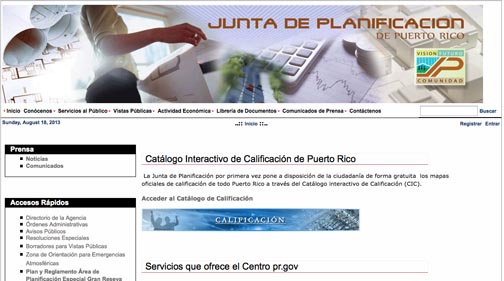Univ. of Puerto Rico tapped by Planning Board to improve data analysis

The Puerto Rico Planning Board and the University of Puerto Rico, Mayagüez Campus (RUM), recently entered a collaborative agreement for the Planning Board to receive technical and academic assistance in producing quarterly gross domestic product accounts and streamlining the methodology for preparing the Input-Output Matrix (IOM) model.
“The economic statistics produced by the Planning Board are crucial for revenue projections, the budget, government credit and the establishment of data-based public policy,” said Planning Board President Julio Lassús-Ruiz. “With this agreement, we continue to strengthen the specialized work we do at the Planning Board, which is essential for the socioeconomic development of Puerto Rico.”
RUM Chancellor Agustín Rullán-Toro stated: “This agreement marks a significant milestone in our academic mission and serving society. The collaboration between the Mayagüez campus of the University of Puerto Rico and the Planning Board is crucial for strengthening the foundations of Puerto Rico’s socioeconomic development.
“The technical and academic assistance we will provide directly contributes to informed decision-making in the government sector. At RUM, we take pride in being part of this initiative that promotes progress and transparency in government activities and strategic planning for the economic growth of our island.”
With assistance from the Agricultural Experimental Station (EEA, in Spanish), affiliated with RUM’s College of Agricultural Sciences (CCA, in Spanish), the Planning Board will integrate quarterly gross domestic product reports and statistics into its regular economic reports on Puerto Rico, both retroactively and prospectively.
The integration will facilitate analysis and update the technology and methodology for the 2017 IOM model, which will be available by senate district.
The EEA has the necessary academic personnel and technological resources to fulfill the agreement’s requirements, totaling costs of $997,722.
Professor Julio César Hernández of the CCA Agricultural Education and Rural Sociology Department and assistant professor Ricardo Fuentes-Ramírez of the Economics Department will lead the project.
“The project aims to develop a technological application to facilitate the collection and processing of data from different government agencies and private entities in order to generate the analysis of the economic accounting system of the IOM as quickly as possible for use by the Planning Board and other state and federal government agencies in decision-making,” explained Lassús-Ruiz.
“Once these new mechanized procedures are developed, they will allow for the construction of annual input-output matrices. It should be noted that the five-year matrices are reference matrices and require more time to be completed,” he continued.
“It helps us have technology to optimize the work we have been doing. It is the first time in a five-year period that we have updated two IOMs. With this agreement, we will be able to publish the next one more efficiently and in less time,” Lassús-Ruiz added.
The IOM serves as an economic accounting system that uses interindustrial analysis to measure the effects on various sectors and industries within social accounts through industrial interrelationships. It acts as a descriptive framework, displaying the connections between industries and sectors of Puerto Rico’s economy over specified periods.
Input-output accounting, which requires all data from basic social accounts, offers a more comprehensive social accounting system than traditional income and expenditure accounts. The model is useful in impact analysis, multipliers, occupational matrices, capital matrices, interindustry linkage measurements, industry-specific productivity studies, and occupation-specific productivity studies.
It also serves as a basis for income distribution studies, applications in international and interregional trade, price models, input-output linear programming models, dynamic input-output models, structural change analysis, spatial (or regional) location models, projections, cost analysis and inflation analysis.
Lassús-Ruiz emphasized “the need to incorporate advanced technology in the preparation of the Input-Output Matrix and the development of quarterly accounts, especially given their use by various government entities and the private sector. Socioeconomic statistics are important because they are used to support policies for economic growth, resource allocation, monitoring Puerto Rico’s economic evolution and progress, and increasing transparency in government.”
Quarterly accounts update trends in aggregate demand and productive sectors, vital for planning private investment and formulating economic development and industrial promotion strategies by government agencies, keeping the local economy’s profile current.
“The quarterly estimates of social accounts provide a view of current short-term economic developments for decision-making by the government and users in general,” concluded the Planning Board president. “By making these reports available to the government and the private sector, we foster an environment of transparency, certainty and reliability that enables all sectors to be proactive, plan and make informed decisions for the development of initiatives.”







